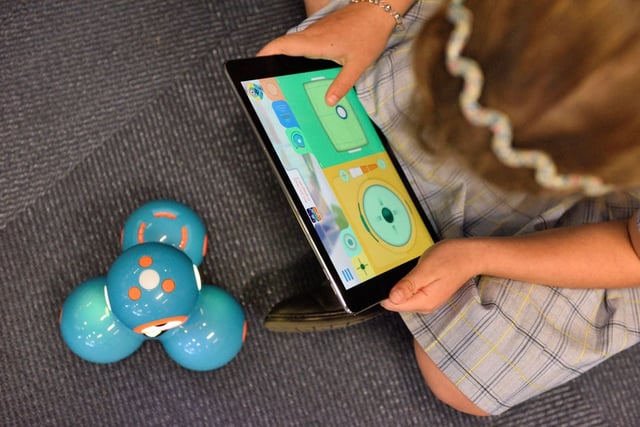What Are Career Readiness Skills in an Automated World?
 Written By Anna McVeigh-Murphy
Written By Anna McVeigh-Murphy
It’s no secret that the work landscape is changing. And no, I’m not talking about the advent of ping pong tables and cold brew taps in offices. I’m instead talking about the predominance of technology across all industries and job functions and the multi-faceted effects of this trend, including its impact on the future of work.
Among the most influential of these technology advances is automation from AI (technology that mimics human intelligence), machine learning (technology that improves at a task over time), and robotics (technology capable of performing a series of actions).
What Can and Cannot Be Automated?
Automation is something that companies and people are increasingly embracing because of its ability to cut out redundancies and busy work, which saves time, shifts focus to what’s more important and critical, and invents new ways to grow and perform.
Increasing automation acutely impacts routine and physical functions, which are prescriptive, replicable tasks that could range from routing calls in an office to checking out books in school libraries to taking a patient’s blood pressure in a hospital.
Automation is not as effective at performing non-routine functions in the workplace. These functions are cognitive and social tasks that require critical thinking and situational adaptability like managing workplace conflict, teaching students how to use different types of media for research, or performing an emergency surgery.
Moreover, the impacts of automation are two-fold: automation changes the nature of available jobs by both replacing some and creating new work opportunities; automation also changes career readiness skills.
Impact of Automation: High-Skill and Middle-Skill Job Growth
If we speak broadly, there are three common categories for job functions: high skill (requiring at least a bachelor’s degrees), middle skill (requiring at least a high school diploma and technical training), and low skill (generally requiring a high school diploma).
While the number of low-skill jobs are shrinking, we are seeing growth in the number of high-skill and middle-skill jobs, and this growth significantly outpaces the size of the current applicant pool. Specifically, a report by Burning Glass Technologies found:
- High-skill jobs have 25 percent more job openings than qualified workers.
- Middle-skill jobs have 13 percent more openings than qualified workers.
- Low-skill jobs, however, have seven percent fewer openings than workers.
To help contextualize this data, we’ve identified the fastest declining occupations between 2016 and 2026 and the fastest growing occupations between 2016 and 2026, according to the Bureau of Labor Statistics.

Takeaways: The occupations in decline are typically low skill. These low-skill roles are either automatable or outdated due to shifting workplace expectations – like telephone and computer operation – which we will discuss in the next section.

Takeaways: The fastest growing occupations tend to be middle and high skill. In these categories, STEM fields predominate. Simultaneously, new roles in industries like healthcare are arising that serve as a more human complement to the automated functions.
Moreover, automation is changing the landscape of employment opportunities for today’s rising students. Growing positions entail cognitive, non-routine tasks that a machine simply cannot do. They require career readiness skills like problem solving, creativity, and critical thinking to sustain the new economy.
Impact of Automation: Human Side of Digital Skills
Beyond just the types of roles, career readiness skills are changing. Researchers at Grovo and LinkedIn analyzed job listings to identify the most in-demand skills. Their findings exemplify the predominance of both technology and social and emotional skills for career readiness:
Digital skills: Application use and flexibility, development and digital production, computing, data analysis, digital security, and media literacy
Social and Emotional Skills: Digital etiquette, self-management, project collaboration, communication, and creativity
And in a separate research study by Mckinsey & Company, the accelerating career readiness skills needed between now and 2030 are (first) digital skills and (second) social and emotional skills.
According to the study, there will be a 60 percent increase in the number of hours people spend at work using digital skills between 2016 and 2030. In the same time, there will be a 26 percent increase in the number hours using social and emotional skills. Notably, this growth significantly outpaces the increase seen between 2002 and 2016.
The most relevant digital skills for career readiness, as identified in the report, needed between now and 2030 are:
- Advanced IT skills and programming
- Basic digital literacy skills
- Technology design, engineering and maintenance
- Scientific research and development
- Advanced data analysis and mathematical skills
The most needed social and emotional skills for career readiness between now and 2030 are:
- Leadership and managing others
- Entrepreneurship and initiative-taking
- Interpersonal skills and empathy
- Advanced communication and negotiation skills
- Adaptability and continuous learning
- Teaching and training others
This confluence of digital and social and emotional skills is a defining feature of career readiness.
“Accompanying the adoption of advanced technologies into the workplace there will be an increase in the need for workers with finely tuned social and emotional skills—skills that machines are a long way from mastering.” Mckinsey & Company
Career Readiness for Students
Because of the changing workforce, the way students are expected to learn must be adapted so that rising students can develop the career readiness skills needed in the 21st century workforce. This shift must prepare students for both new and evolved roles. Here are three ways education can equip students with career readiness skills.
1. Developing Foundational Digital Skills
Productivity lost due to low digital skills is estimated to cost the US economy 1.3 trillion dollars each year. And time wasted as a result of inadequate digital skills adds up to 21 percent of a worker’s time, costing businesses roughly $10,000 per employee annually.
Students need to develop basic digital skills to navigate digital interfaces, access the resources they need, and perform basic functions. It’s not glamorous, I know, but these career readiness skills also enable the other ways education must evolve as discussed below.
How do we achieve this? We make these foundational to learning. We teach students to partner with technology – to build a relationship with it and leverage it throughout their learning experience. We teach them to use it, to troubleshoot it, to create with it, and to collaborate through it.
2. Learning How to Learn
Due to rapid technology advances, career readiness includes the ability to constantly re-skill and upskill to keep up with change. For example, a Dell Technology report found that 85 percent of forecasted jobs for 2030 still do not exist yet largely because technology is expanding so rapidly. Students are preparing for jobs that are yet to be imagined. When they graduate, they need to know how to adapt to the roles available to them.
Similarly, a Deloitte report finds that the half-life of skills is now five years and companies will need to invest in continual professional development for workers, meaning that career readiness skills entail knowing how to learn, adapt, and embrace change and ambiguity.
How do we achieve this? We develop students’ cognitive skills by focusing on the process of discovery and problem solving. We teach students to have a growth mindset, to persevere, and to lead.
3. Building Interest in Technology Early
Another significant need for today’s students is building interest in technology, computer science, and STEM. 1.8 mill IT jobs could go unfilled by 2022 with only 600,000 IT graduates from higher education every year.
Within these graduates, there is significant underrepresentation of minority groups. For example, a Brookings report found that: “Blacks make up 11.9 percent of all workers but only 7.9 percent of [computer and mathematical] workers. The gap is even larger for Hispanics, who make up 16.7 percent of all workers but only 6.8 percent of [computer and mathematical] workers.”
Additionally, women comprise only twenty percent of the workforce in these fields. And this data is just an overview—the number of minorities represented in these undergraduate classes, AP classes, and electives is just as stark. We need to increase representation and interest in these to fill the coffer of graduates capable of assuming these IT and STEM positions.
How do we achieve this? We introduce students to technology early and inclusively. We frame technology, STEM, and computer science as intensely creative and collaborative fields. We spark interest with relevant learning experiences. We embed technology practice into core curriculum. We use technology to change our approach to assessment, homework, and instruction. We redefine the learning experience.




